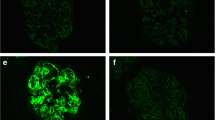Abstract
A 71-year-old woman presented with massive proteinuria and microhematuria. Renal biopsy showed diffuse global membranoproliferative and endocapillary proliferative lesions with leukocytic infiltration and an irregular duplication of the glomerular basement membrane on light microscopy. Immunofluorescence study showed granular deposits of monoclonal immunoglobulin G3 (IgG3) kappa, C3, and C1q in the glomeruli. Electron microscopy revealed unique structurally organized microlamellar electron-dense deposits. There was no evidence of systemic diseases such as paraproteinemia, cryoglobulinemia, or systemic lupus erythematosus. Following renal biopsy, the oral administration of mizoribine in addition to predonisolone gradually improved the patient’s clinical status. So far, partial remission has continued for a year, and she has not been affected with hematopoietic or lymphoproliferative disorders. We report a case of proliferative glomerulonephritis with unusual microlamellar organized deposits related to monoclonal IgG3 kappa. Our case was immunologically identical to proliferative glomerulonephritis with monoclonal IgG deposits (PGNMID). Therefore, we concluded that our case should be categorized as an atypical form of PGNMID, though it was difficult to diagnose using the usual diagnostic approach to glomerular diseases with organized deposits.



Similar content being viewed by others
References
Iskandar SS, Falk RJ, Jennette JC. Clinical and pathologic features of fibrillary glomerulonephritis. Kidney Int. 1992;42(6):1401–7.
Joh K. Pathology of glomerular deposition diseases. Pathol Int. 2007;57(9):551–65.
Herrera GA, Turbat-Herrera EA. Renal diseases with organized deposits: an algorithmic approach to classification and clinicopathologic diagnosis. Arch Pathol Lab Med. 2010;134(4):512–31.
Muchtar E, Magen H, Gertz MA. How I treat cryoglobulinemia. Blood. 2017;129(3):289–98.
Bridoux F, Hugue V, Coldefy O, Goujon JM, Bauwens M, Sechet A, Preud’Homme JL, Touchard G. Fibrillary glomerulonephritis and immunotactoid (microtubular) glomerulopathy are associated with distinct immunologic features. Kidney Int. 2002;62(5):1764–75.
Motwani SS, Herlitz L, Monga D, Jhaveri KD, Lam AQ, American Society of Nephrology Onco-Nephrology F. Paraprotein-related kidney disease: glomerular diseases associated with paraproteinemias. Clin J Am Soc Nephrol. 2016;11(12):2260–72.
Nasr SH, Valeri AM, Cornell LD, Fidler ME, Sethi S, Leung N, Fervenza FC. Fibrillary glomerulonephritis: a report of 66 cases from a single institution. Clin J Am Soc Nephrol. 2011;6(4):775–84.
Nasr SH, Markowitz GS, Stokes MB, Seshan SV, Valderrama E, Appel GB, Aucouturier P, D’Agati VD. Proliferative glomerulonephritis with monoclonal IgG deposits: a distinct entity mimicking immune-complex glomerulonephritis. Kidney Int. 2004;65(1):85–96.
Nasr SH, Satoskar A, Markowitz GS, Valeri AM, Appel GB, Stokes MB, Nadasdy T, D’Agati VD. Proliferative glomerulonephritis with monoclonal IgG deposits. J Am Soc Nephrol. 2009;20(9):2055–64.
Doshi M, Lahoti A, Danesh FR, Batuman V, Sanders PW, American Society of Nephrology Onco-Nephrology F. Paraprotein-related kidney disease: kidney injury from paraproteins—what determines the site of injury? Clin J Am Soc Nephrol. 2016;11(12):2288–94.
Bridoux F, Leung N, Hutchison CA, Touchard G, Sethi S, Fermand JP, Picken MM, Herrera GA, Kastritis E, Merlini G, Roussel M, Fervenza FC, Dispenzieri A, Kyle RA, Nasr SH, International K, Monoclonal Gammopathy Research G. Diagnosis of monoclonal gammopathy of renal significance. Kidney Int. 2015;87(4):698–711.
Joh K, Aizawa S, Takahashi T, Hatakeyama M, Muto S, Asano Y, Shimizu H, Suzuki R. Microlamellar structures in lobular glomerulonephritis associated with monoclonal IgG lambda paraproteinemia. A case report and review of the literature. Acta Pathol Jpn. 1990;40(12):913–21.
Acknowledgements
We thank Dr. Masakazu Akashi (Department of Nephrology, Kita-Asaka station clinic, Saitama, Japan) for helpful comments and Ms. Arimi Ishikawa (Department of Analytic Human Pathology, Nippon Medical School, Tokyo, Japan) for expert technical assistance.
Author information
Authors and Affiliations
Corresponding author
Ethics declarations
Conflict of interest
The authors declare that they have no competing interests.
Human and animal rights
All procedures performed in this case report were in accordance with the ethical standards of the institutional committee and with the 1964 Helsinki declaration and its later amendments or comparable ethical standards.
Informed consent
Written informed consent was obtained from the patient for publication of this case report and any accompanying images. This study does not contain any studies with animals performed by any of the authors.
About this article
Cite this article
Mii, A., Shimizu, A., Takada, D. et al. Proliferative glomerulonephritis with unusual microlamellar organized deposits related to monoclonal immunoglobulin G3 (IgG3) kappa. CEN Case Rep 7, 320–324 (2018). https://doi.org/10.1007/s13730-018-0351-0
Received:
Accepted:
Published:
Issue Date:
DOI: https://doi.org/10.1007/s13730-018-0351-0




